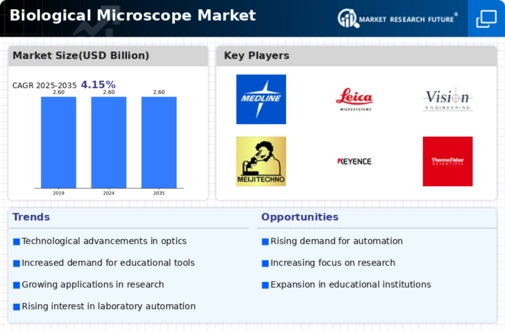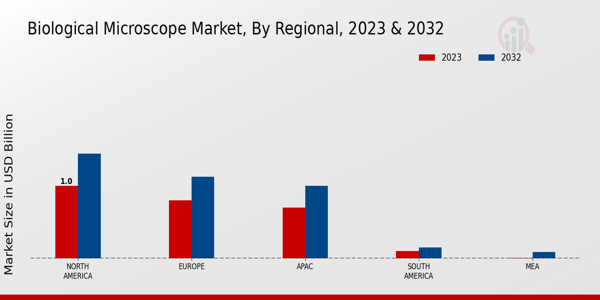Technological Advancements
The Global Biological Microscope Market Industry is experiencing a surge in demand due to rapid technological advancements. Innovations such as digital imaging, automated focusing, and enhanced illumination systems are transforming traditional microscopy. These advancements not only improve image quality but also increase the efficiency of biological research. For instance, the integration of artificial intelligence in microscopy is enabling researchers to analyze complex biological samples with unprecedented accuracy. As a result, the market is projected to maintain a steady valuation of 2.6 USD Billion in 2024, reflecting the industry's adaptation to cutting-edge technologies.
Emerging Markets and Global Expansion
Emerging markets are becoming increasingly vital to the Global Biological Microscope Market Industry. Countries in Asia-Pacific and Latin America are investing in healthcare and education, leading to heightened demand for biological microscopes. As these regions develop their research infrastructure, the need for advanced microscopy tools is expected to rise. This expansion into new markets may contribute to a stable CAGR of 0.0% from 2025 to 2035, as established manufacturers seek to capitalize on growth opportunities in these regions.
Increasing Applications in Healthcare
The Global Biological Microscope Market Industry is witnessing a significant uptick in applications within the healthcare sector. Microscopes are crucial for diagnostics, research, and quality control in laboratories. The growing prevalence of diseases necessitates advanced diagnostic tools, and biological microscopes play a pivotal role in identifying pathogens and cellular abnormalities. As healthcare providers prioritize precision medicine and personalized treatment plans, the reliance on advanced microscopy techniques is likely to grow. This trend suggests a stable market valuation of 2.6 USD Billion by 2035, as healthcare continues to evolve.
Rising Research and Development Activities
Increased investment in research and development across various sectors is driving growth in the Global Biological Microscope Market Industry. Academic institutions, pharmaceutical companies, and biotechnology firms are allocating substantial resources to enhance their research capabilities. This trend is particularly evident in the life sciences sector, where advanced microscopy techniques are essential for understanding cellular processes. The sustained focus on R&D is likely to ensure that the market remains valued at 2.6 USD Billion by 2035, as organizations seek to leverage advanced microscopy for innovative discoveries.
Growing Demand from Educational Institutions
Educational institutions are increasingly adopting advanced biological microscopes to enhance their teaching methodologies, thereby propelling the Global Biological Microscope Market Industry. The incorporation of modern microscopy in curricula allows students to engage in hands-on learning experiences, fostering a deeper understanding of biological concepts. This trend is particularly pronounced in higher education, where institutions are investing in state-of-the-art equipment. As educational budgets expand, the demand for biological microscopes is expected to remain robust, contributing to the market's stability at 2.6 USD Billion in 2024.


















Leave a Comment